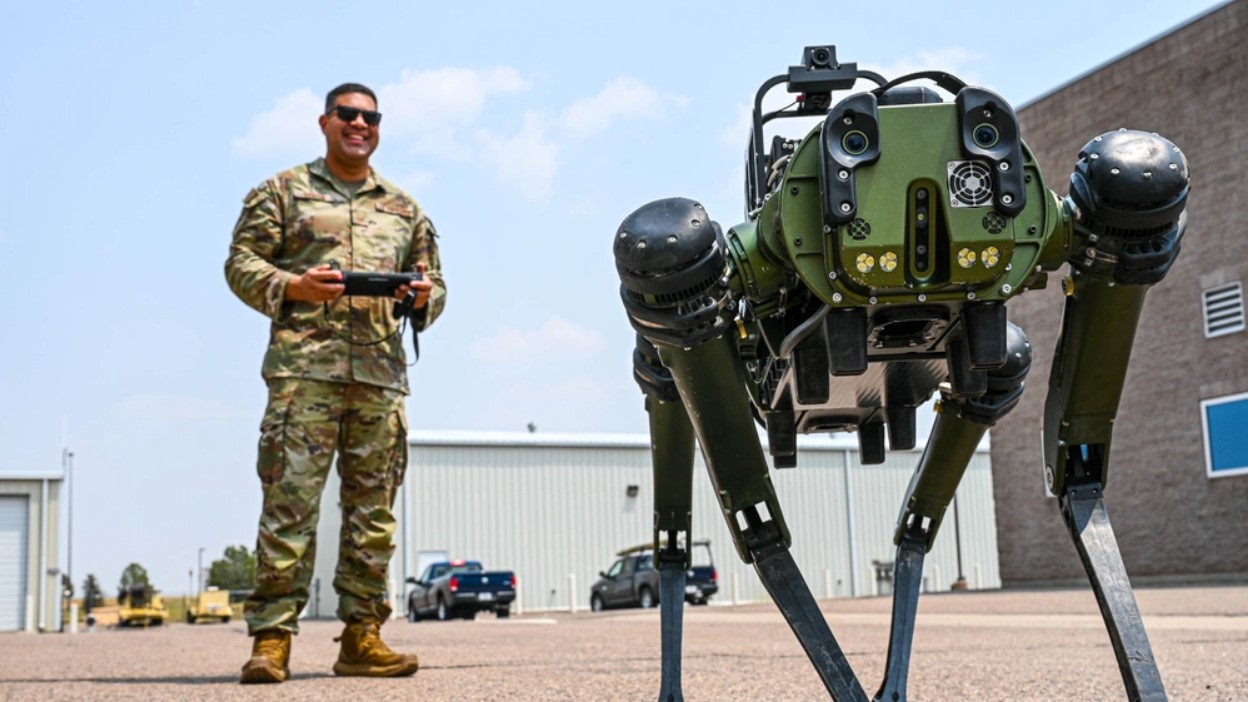

Troops stationed at Buckley Space Force Base in Aurora, Colorado might notice an odd four-legged robot loping around the base. That’s CHAPPIE. The Space Force has a robot dog that hunts down dangerous material. And yes, it is apparently named after “Chappie,” the 2015 Neil Blomkamp-directed science-fiction movie where a police robot is stolen by members of the South African rap group Die Antwoord and becomes a criminal-slash-revolutionary.
Space Force’s CHAPPIE has been in use on the base since July, according to the dates on some photos released by the service. The robot, according to Space Force, is one of only two quadrupedal unmanned ground vehicles in the entire Department of Defense to be dedicated to chemical, biological, radiological and nuclear (or CBRN) detection. And it ended up at a Space Force base, named for a film where Hugh Jackman — sporting a mullet — tries to replace crime-fighting robots with a giant mecha.
The idea for CHAPPIE — the real-life robot, not the movie robot — dates back to years earlier in the Middle East. U.S. Air Force Master Sgt. Dominic Garcia was then stationed at Dyess Air Force Base, Texas, having previously deployed to Syria as part of the anti-ISIS fight. American troops were hunting down ISIS chemical weapons.
“I thought there had to be a safer and faster way. In 2022, while stationed at Minot, I applied for a Small Business Innovation Research Grant through [the Department of the Air Force’s technological grant program] AFWERX,” Garcia said in the Space Force release. “I received $1.24 million to develop a remote CBRN sensing capability using our current inventory of detectors. Within 20 months, we reached 90% of our goal, conducting tests at the Defense Threat Reduction Agency and Dugway Proving Ground.”
Subscribe to Task & Purpose today. Get the latest military news and culture in your inbox daily.
Using robots to help with CBRN detection and neutralization isn’t new; the military has been working on that in recent years. However, when it comes to this role, CHAPPIE’s design is. And it’s an increasingly familiar design: it’s a modified robot dog. CHAPPIE is heavily outfitted with sensors and detectors already in use by the military to identify and track nuclear or chemical traces. The four-legged machines have become a popular tool in militaries worldwide. Military and commercial ones have been used for everything from patrolling bases in the United States or marketed at arms conventions with a rocket-propelled grenade launcher mounted on them.
This CHAPPIE is operated by Garcia via a video game controller-like device, rather than being a fully autonomous police robot that Dev Patel tests an artificial intelligence program on. These types of controllers have become increasingly popular within the military, both for efficiency and familiarity from users.
According to the Space Force’s release, the military and Garcia are working on improving CHAPPIE’s efficiency. That means newer sensors, making it more mobile and — yes — possible artificial intelligence additions.
The latest on Task & Purpose
- Marine recruit flees boot camp, stopped at airport
- Navy fires commander of San Diego Leadership and Ethics Command
- Air Force fires commander at Montana nuclear missile base after investigation
- DoD can’t confirm whether North Korean troops in Russia are ‘gorging on pornography’
- An enemy commander told him to surrender. This Army captain threw a grenade instead.
